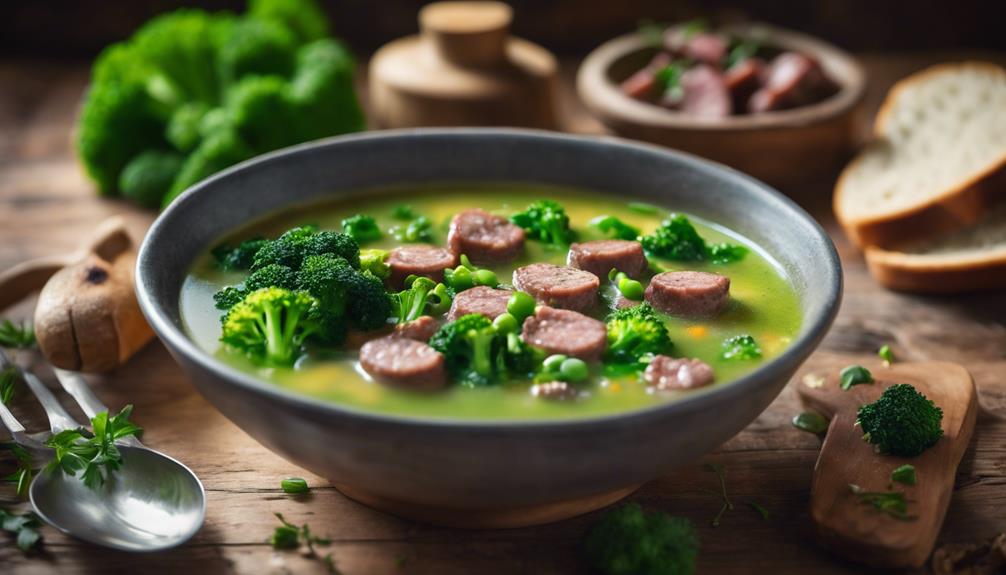Immerse yourself in a nourishing culinary journey with Sausage and Broccoli Rabe Soup. This dish offers a healthier twist on the classic Italian recipe by combining savory sausage with nutrient-rich greens like broccoli rabe. With approximately 229 calories per serving, this soup provides a balanced profile of protein and fiber to keep you satisfied. Enhance the experience by simmering the soup until the broccoli rabe is tender and sprinkling parmesan cheese atop. Serve alongside crusty bread for a fulfilling meal. For more serving suggestions, freezing tips, and detailed meal prep instructions, a world of culinary excellence awaits your exploration.
Key Takeaways
- Nutritious twist on Italian classic with turkey sausage and broccoli rabe.
- Protein-packed and fiber-rich for a wholesome meal option.
- Savory and satisfying flavors with a rich, comforting broth.
- Serve with crusty bread and a side salad for a complete meal.
- Freeze for up to 3 months, perfect for meal prep and convenience.
Healthier Twist on Italian Classic
For a healthier take on the classic Italian dish, this sausage and broccoli rabe soup offers a nutritious twist without compromising on taste.
The bitterness of the broccoli rabe perfectly complements the savory flavors of the sausage, creating a rich and satisfying soup.
By using turkey sausages instead of pork, this soup becomes lighter while still retaining its delicious essence. When you heat up this soup, the aromas of the sausage and broccoli rabe will fill your kitchen, making your mouth water in anticipation.
This soup isn't only delicious but also practical. Its freezable nature allows for easy storage, making it a convenient option for healthy lunches or quick meals.
With the addition of extra vegetables and lean protein from the sausage, this hearty soup serves as a fulfilling main course, especially ideal for colder weather.
Enjoy a bowl of this comforting soup knowing you're indulging in a wholesome meal that nourishes your body.
Nutritious Main Course Option

To make a nutritious main course option, consider the protein-packed Sausage and Broccoli Rabe Soup, rich in essential nutrients and fiber. This hearty soup derives its protein content from the savory sausage and nutrient-dense broccoli rabe, making it a substantial meal choice.
Broccoli rabe, with its slightly bitter taste, not only adds depth to the flavors but also contributes to the fiber content of the dish. The combination of protein and fiber in this soup can help keep you feeling full and satisfied for longer periods.
Furthermore, the Sausage and Broccoli Rabe Soup is a beneficial source of essential nutrients, offering a well-rounded meal option. With approximately 229 calories and 9g of total fat per 2-cup serving, this soup provides a balanced nutritional profile suitable for those seeking a wholesome and fulfilling dining experience.
Satisfying Flavor Profile

Indulge in the robust and comforting flavors of sausage and broccoli rabe soup, a culinary delight that tantalizes the taste buds with its hearty combination.
The marriage of spicy Italian sausage and bitter broccoli rabe in this soup creates a unique and satisfying flavor profile that's both savory and fulfilling.
The richness of the broth enhances the overall experience, making each spoonful a burst of deliciousness.
This soup, serving as a main course, not only meets your hunger but also offers a symphony of flavors that dance on your palate.
The hearty nature of this dish, packed with protein from the sausage and essential nutrients from the broccoli rabe, guarantees a wholesome and fulfilling meal.
By opting for turkey sausages and adding extra vegetables like carrots and celery, you can further enrich the flavor profile while making a healthier choice.
With each spoonful, you'll experience a perfect blend of textures and tastes that will leave you craving more of this flavorful and hearty soup.
Serving Suggestions and Pairings

Enhance your dining experience with simple yet satisfying serving suggestions and pairings for the sausage and broccoli rabe soup. To start, prepare the soup in a dutch oven by combining sautéed sausage, red pepper flakes for a kick of heat, and chicken broth. Let the flavors meld together as you let the soup simmer for 20 minutes until the broccoli rabe is tender.
Once ready, ladle the soup into bowls and sprinkle a generous amount of grated parmesan cheese on top for a savory and creamy touch.
For a complete meal, pair the soup with a side of crusty bread to soak up the flavorful broth. The hearty and nutritious nature of the soup makes it an ideal main course for lunch or dinner.
To round out the meal, serve the soup alongside a fresh side salad for a well-balanced dining experience. Whether enjoyed fresh or frozen for later convenience, this sausage and broccoli rabe soup is sure to satisfy your cravings for a comforting and flavorful meal.
Freezing and Meal Prep Tips

Maximize convenience by incorporating freezing and meal prep tips to extend the longevity and ease of enjoying your sausage and broccoli rabe soup.
To freeze your soup successfully, make sure it cools completely. Once cooled, transfer it into airtight containers or freezer bags before placing it in the freezer. Stored properly, your soup can last for up to 3 months. When you're ready to enjoy your frozen soup, thaw it in the refrigerator overnight. Then, reheat it on the stovetop or in the microwave for a quick and delicious meal.
For added convenience, consider dividing your soup into individual portions before freezing. This will make it easier to thaw and reheat only what you need, saving you time and effort.
Additionally, a helpful meal prep tip is to make a double batch of the soup. Enjoy one portion fresh and freeze the other half for a convenient meal option on busy days.
Frequently Asked Questions
Does Broccoli Rabe Taste Good?
Yes, broccoli rabe tastes good! Its slightly bitter and nutty flavor adds depth to dishes. Packed with vitamins and fiber, it's a versatile ingredient that enhances soups, pastas, and more when cooked and seasoned properly.
Do You Eat the Whole Broccoli Rabe?
When enjoying broccoli rabe, you eat the whole plant, from its leafy greens to its crunchy stems. Embrace its bitter charm by cooking until tender. Savor the vitamins and minerals it offers!
How Many Calories Are in Sausage and Broccoli Rabe?
You'll find approximately 229 calories in sausage and broccoli rabe soup. It's a hearty option with 17 grams of protein and 9 grams of fat, making it a satisfying and flavorful choice filled with nutrients.
What Is Rabe in Cooking?
In cooking, rabe, short for rapini, is a leafy green veggie with a slight bitterness. It's a versatile ingredient, commonly used in Italian dishes. Broccoli rabe adds texture and pairs well with flavors like garlic and sausage.
What Are Some Other Ways to Incorporate Broccoli Rabe into Meals Besides Soup?
Looking for new ways to enjoy nutritious broccoli rabe? Try sautéing it with olive oil and garlic for a tasty side dish. You can also roast it with a sprinkle of Parmesan cheese or incorporate it into a fresh pasta dish for a healthy and flavorful meal.
Conclusion
To sum up, this sausage and broccoli rabe soup offers a hearty and flavorful twist on a classic Italian dish. With its nutritious ingredients and satisfying taste, it's sure to become a staple in your meal rotation.
Whether enjoyed on its own or paired with your favorite side dishes, this soup is a versatile and delicious option for any occasion.
So why not give it a try and elevate your culinary experience with this delicious and comforting meal?










